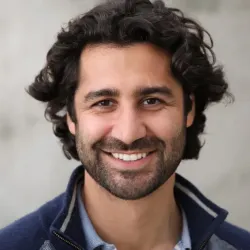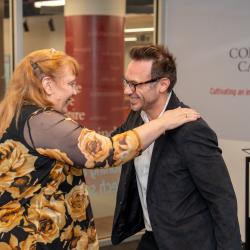From UMD to AI CEO: Debanjan Saha’s ‘Wild and Fascinating Journey’
Thirty years after earning his Ph.D. in computer science, Saha will return this May as the keynote speaker for the CMNS Graduate Commencement Ceremony.
When Debanjan Saha (M.S. ’93, Ph.D. ’95, computer science) began graduate school at the University of Maryland in 1990, he was captivated by the rapidly evolving world of computer technology—but he had no idea just how far it would take him.

“I knew it was going to have a huge impact, but I had no idea where it would lead me,” Saha reflected. “And honestly, I still don’t know where AI will take us. It’s been a wild and fascinating journey.”
That journey has spanned three decades of innovation, exploration and leadership. Saha has held pivotal roles and led groundbreaking projects at some of the world’s most influential tech companies, including IBM, Google and Amazon. Today, as CEO of DataRobot, he is driving the global expansion of the company’s cutting-edge artificial intelligence (AI) platform. His mission: to make AI accessible to everyone and empower organizations to solve real-world challenges safely and responsibly.
With more than 50 patents to his name and recognition as an IEEE Fellow and a distinguished member of the Association for Computing Machinery, Saha credits his success to an insatiable curiosity and a willingness to take bold risks.
“My philosophy is simple: stay curious,” he said. “What excites me is learning something new. I want to do things that haven’t been done before. And I’m not afraid to take risks—because if you fear failure, you won’t take chances. And without taking chances, you can’t do anything truly big or interesting.”
This May, Saha will embark on another first—delivering the keynote address for the College of Computer, Mathematical, and Natural Sciences Graduate Commencement Ceremony at UMD.
“It’s the first time I’ve been invited to do something like this, and it’s such an honor to return to the place that shaped who I am,” Saha said. “UMD was transformative for me. Being able to speak to graduates, knowing I once sat where they are now—that’s incredibly exciting.”
From Darjeeling to College Park
Saha grew up in Darjeeling, India—“a Himalayan town famous for its tea”—where a love for mathematics eventually led him to computer science. He earned his undergraduate degree from the Indian Institute of Technology in Kharagpur before heading to Maryland for graduate school.
“At UMD, I learned how to solve problems—how to channel my curiosity into asking the right questions and finding better solutions,” he said. “But perhaps even more importantly, I learned how to argue and articulate ideas.”
As a teaching assistant in the Department of Computer Science, Saha found joy in the academic environment and briefly considered a career in academia. But the call of industry innovation was too strong to ignore. It was an era of explosive growth in computing—the internet was just taking off, and the possibilities seemed endless.
“There were many directions I could have taken my thesis, including AI,” he recalled. “But I chose not to focus on AI because I wasn’t sure it would lead to a job. Ironically, now I run an AI company. But I believe it was the right call at the time. I saw the internet’s potential, and by the time I graduated, it was booming.”
From China to California
After completing his Ph.D. in 1995, Saha joined IBM Research before moving to Tellium, an optical networking startup, where he helped develop next-generation optical switches. He returned to IBM in 2004 and made a significant mark—leading a major data analytics project for the U.S. Department of Defense and spearheading innovations in data storage that evolved into a billion-dollar business.
By 2012, Saha was managing IBM development labs in India and China. That international stint also fulfilled a personal curiosity.
“I grew up on the Indian side of the Himalayas, and I’d always wondered what was on the other side,” he said. “Someone told me you could go to Lasha in Tibet, rent a car and drive to Everest Base Camp. It sounded amazing—until I got altitude sickness at 17,000 feet and ended up spending three days in a Tibetan hospital. Unforgettable.”
Saha’s journey next brought him to Silicon Valley, where he led Amazon Web Services’ (AWS) database business, launching Amazon Aurora—the fastest-growing service in AWS history. Later, he drove the advancement of Google Cloud’s data analytics capabilities, including BigQuery.
On to the next frontier
In 2022, Saha decided it was time to pursue the next frontier: AI.
“I knew AI was where the future was headed,” he said. “And I wanted to be a part of shaping that future.”
As CEO of DataRobot, Saha’s goal is to simplify and democratize AI for a broad audience.
“AI is inherently complex, and we want to automate much of that complexity so people without advanced degrees can use it to solve their problems,” he explained. “But it’s not just about access. It’s about value. For AI to be impactful—socially or economically—it needs to solve real problems.”
Limitless possibilities
Looking ahead to his commencement speech, Saha hopes to share a story that resonates—not only about where he’s been, but where the next generation might go.
“I plan to talk a bit about my own journey and contrast it with today’s landscape,” he said. “AI is going to reshape the workforce, so I want to help graduates think about how to use AI to complement their strengths, not compete with it.”
And if there’s one message he wants to leave them with, it’s this: the possibilities are endless.
“There are always opportunities—you just have to create them,” Saha said. “A strong education gets you through the first door. What you do from there determines how many more you can open. I truly believe the possibilities are limitless. And that’s what makes this moment so exciting."







